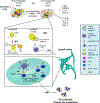Oncolytic viruses and immunity
- PMID: 29550660
- PMCID: PMC9285655
- DOI: 10.1016/j.coi.2018.03.008
Oncolytic viruses and immunity
Abstract
Initially, direct oncolysis was thought to be the sole mechanism through which oncolytic viruses (OVs) exert their anti-tumor effect, and the immune system was perceived as the major obstacle in oncolytic virotherapy. Over the last decade, there has been a lot of debate on whether the immune system is a friend or foe of OVs. However, we are now at a stage where the initial thinking has been reversed as a result of compelling evidence that the immune system plays a critical role in the success of oncolytic virotherapy. In this review we discuss the importance of the involvement of innate and adaptive immunity for therapeutic efficacy of OVs, and the rational combination of OVs with other immunotherapies for further enhancement of overall therapeutic outcome.
Copyright © 2018 Elsevier Ltd. All rights reserved.
Figures

References
-
- Hanahan D, Weinberg RA: Hallmarks of cancer: the next generation. Cell 2011, 144:646–674. - PubMed
-
- Hashiro G, Loh PC, Yau JT: The preferential cytotoxicity of reovirus for certain transformed cell lines. Arch Virol 1977, 54:307–315. - PubMed
-
- Coffey MC, Strong JE, Forsyth PA, Lee PW: Reovirus therapy of tumors with activated Ras pathway. Science 1998, 282:1332–1334. - PubMed
-
- Stojdl DF, Lichty B, Knowles S, Marius R, Atkins H, Sonenberg N, Bell JC: Exploiting tumor-specific defects in the interferon pathway with a previously unknown oncolytic virus. Nat Med 2000, 6:821–825. - PubMed
-
- Heise C, Hermiston T, Johnson L, Brooks G, Sampson-Johannes A, Williams A, Hawkins L, Kirn D: An adenovirus E1A mutant that demonstrates potent and selective systemic anti-tumoral efficacy. Nat Med 2000, 6:1134–1139. - PubMed
Publication types
MeSH terms
Grants and funding
LinkOut - more resources
Full Text Sources
Other Literature Sources

